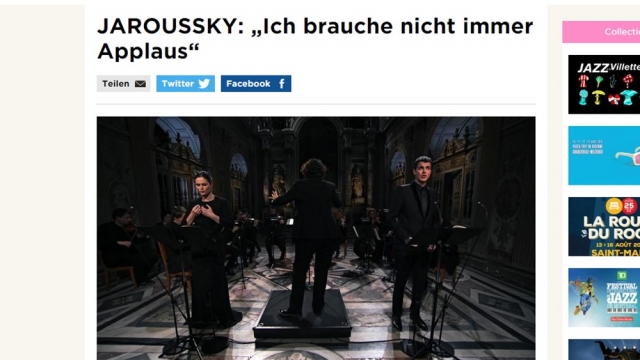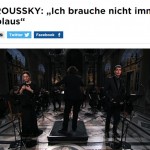2015-03-02, ARTE Magazin
“Als wir den französischen Countertenor Philippe Jaroussky im Dezember zum Interview treffen, hat er am Vorabend das Hamburger Publikum mit Sakralmusik von Vivaldi begeistert. Heute gibt es erst einmal Kamillentee. Philippe Jaroussky kämpft mit der komplizierten Teesieb-Konstruktion – begegnet dem Kratzen im Hals aber gelassen”…
Source/Read more: Arte Concert
The following is not a professional translation; no profit is being made, no infringement of copyright is intended
Jaroussky: “I don’t always need applause”
The charismatic countertenor Philippe Jaroussky pleads for greater openness in music, talks shop about Lady Gaga – and explains why reverent silence can be a competition to any applause.
In December, when we meet the French countertenor Philippe Jaroussky, he had just delighted the Hamburg audience with sacred music by Vivaldi the evening before. Today, first of all, there is chamomile tea. Philippe Jaroussky is struggling with the complicated design of the tea strainer, but is relaxed about his scratchy throat. Apparently, the star of high range singing in can handle pressure quite well. The reason for our meeting is another sacred opus which he is going to perform a little later, together with the Hungarian soprano Emöke Barath, at the magnificent chapel of the Castle Fontainbleau: Pergolesi’s setting to music of the Stabat Mater.
ARTE: A glance at a list of your favourite music reveals: you also like to listen to Pop.
PHILIPPE JAROUSSKY: For me, it’s about an exciting mixture of Classical and Pop. Lorraine Hunt and Cecilia Bartoli next to Lady Gaga and Bruno Mars. I’m not particularly interested in Lady Gaga, but recently, I saw a performance of her on the internet. She was singing Nancy Sinatra’s “Bang Bang” wearing a vermilion leather suit, an enormous wig – but she sang without exaggerating. You can hear the range of her voice, her classical education. She could be one of the greatest Jazz singers of our times, and surely isn’t a Pop monster. We all should open our minds a little more. I have to confess that I didn’t start to discover singers like Ella Fitzgerald or Mercedes Sosa until eight years ago. A veritable shock.Why?
As an opera singer, you have to carry your voice up front, while singers who use a microphone are more free, and a lot more relaxed because first and foremost, it isn’t so much about the voice, but about the meaning of the words.You browse the archives for unknown works, you are devoting yourself to the past. What can you bring from there to the present?There is such an abundance of feelings in Classical music. In contrast, in our society, everything has to be always positive and easily accessible, music has to be danceable. I think that’s totally hysterical!
So we lock our emotions?
We cannot even talk about death. We try to forget about all the weighty matters, and rather like to dance. Now when we hear the “Stabat Mater,” we have to deal with death. After all, there are signs of a trend that turns away from all that is easily consumable. After all, many are bored that there are only the same ten songs on the radio playing over and over. Maybe, this change will contribute to it that people will listen more to classical music again, eventually.The “Stabat Mater” was set to music various times throughout the centuries. What is so special about Pergolesi’s composition from 1736?
Pergolesi was aware that the poem is deeply sad. Nevertheless, he demands a bit of distance to its literal sense. Some passages are musically cheerful, in stark contrast to the text. He knows that he can only achieve the biggest emotional impact at the end if he releases the pressure in between and includes different states of mind.How do you manage to show feelings on stage, and yet to stay vocally exact?
In the end, singing is like acting. You reproduce feelings, you show them, even if you are not feeling them at the moment. For me, it was a learning process.You have sung the “Stabat Mater” three times already, with different partners. What makes it different each time?
I think you sing differently every time. Emöke Barath’s soprano is tender and human; with Julia Lezhneva’s rich and deep voice, our rendition was more reserved, and with my countertenor colleague Valer Sabadus I had the impression that there were two angels singing.I thought you didn’t like this comparison.
I’ve come to be able to accept it better now. Maybe it is a skill that countertenors have: to transport the listener to another world.Which reaction of audience is your favourite?
Sometimes, at the beginning, there is a lot of coughing, at the end, there’s almost no coughing at all. I like it when the audience forgets about coughing. I often enjoy the moment after slow arias, when the audience grants me a few seconds of silence, where there is no noise in the room. Musicians don’t always need applause.Isn’t it sometimes the case that simply no one dares to clap first?
Many younger people are used to go to Pop concerts where you talk during the pieces. In classical concerts, we produce silence. Maybe nowadays we are unaccustomed to being silent for two hours.


